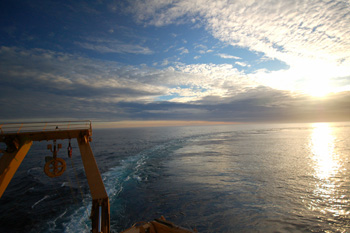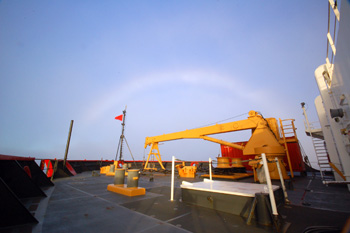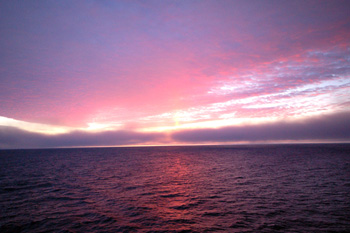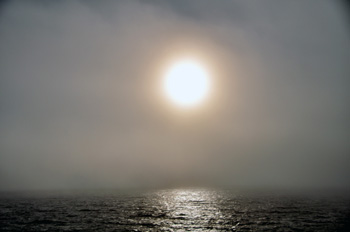September 10thMorning fog has been persistent, barely a ship length’s visibility and only a bone-pale hole in the murk to imply sunlight—the Arctic is selfishly withholding its extravagant light. We’d appreciate more generosity both for practical purposes such as wildlife observation but also for aesthetic appreciation. Generally, the sun succeeds by lunchtime to melt the fog at least on the sun-side of the sky, and we’re treated to glimpses of the high-latitude light show. The Beaufort Sea has been as flat as a skating rink, a reflecting surface for that endless range of gray—how can there be so many grays?—and then contrasting bright, gaudy patches of Caribbean blue and turquoise suddenly appear, if briefly, out at the horizon. Later, ice-bows, orange and yellow and green as improbable as a stage scrim in a melodrama, arc across the water. And every night, we suspect, the Aurora is doing its fantastic number unseen above the low cloud cover.
Watching the afternoon show from the starboard rail, I was thinking about the ocean and about that matter we discussed the other day, its global motion and the interconnectedness, through currents, between one ocean and the others—the singular ocean. I, for one, have been ocean-obsessed since before the age of literacy, but I never, until fairly recently, thought of it in scientific terms. Though I grew up within sight of the Gulf Stream, I never thought to ask why it flowed so fast, or for that matter why there was a Gulf Stream in the first place. I said earlier that Dr. Bob, as a physical oceanographer, wants to understand how the ocean works. I’d never thought of the ocean working. I’d always responded to the ocean on an aesthetic level, to its beauty, even as it was heartlessly pounding on me aboard small sailboats. But working? What do you mean working? Since then I’ve learned a little fizzo, and to my pleasure it has enhanced, enriched my appreciation and respect for the ocean. The Invisible Ocean As Dr. Bob points out, to most people the basic principles of the science are utterly foreign and as for the language, well, you might as well be speaking Lithuanian. Part of the difficulty is that you can’t see oceanography. You can look at a rock face and see geology; marine biologists can visually examine their subject animals. But there’s no way to see those currents coursing through the world ocean. However, we don’t need to use the jargon or the acronyms or, thank God, the math. We can use our imagination to carry us out beyond the horizon and into the sunless depths as if the ocean were art, a movie, say that takes us to places that exist only in the imagination. Let’s try that, moving a step closer to the oceanographic purpose of all this human effort to study the Chukchi and Beaufort seas. And let’s start with a short geographical brush-up. “Arctic Ocean” is something of a misnomer. Technically speaking it’s an enclosed sea (so is the Red Sea, Black Sea, Mediterranean, the Gulf of Mexico, others), that is, one isolated by land from the major ocean basins (Pacific, Atlantic, Indian). Continents and large islands surround the Arctic Ocean and its attendant seas, including this Beaufort Sea. It has very limited communication with the Pacific, through the narrow, shallow Bering Strait, about 85 km wide and only 45 m deep. Atlantic Ocean water enters the Arctic through the Fram Strait, 450 km wide and 3,000 m deep, between Greenland and Scandinavia. There is another opening over the top of Norway, but it’s safe to say that the Arctic is a relatively tightly enclosed sea. The Oceanographic Objective Bob’s purpose, broadly speaking for now, is to study the “Western Arctic Boundary Current” (WABC). Bob calls it a “trickle” compared, say, to the Gulf Stream, which at certain points in its progress transports over 100 million cubic meters of water every second, while the WABC transports slightly under one million cubic meters per second. The transport consists primarily of cold Pacific Ocean water with relatively low salinity through the Bering Strait into the Chukchi and Beaufort seas.
Here we need to introduce a couple other general oceanographic principles. First, bathymetry, that is, the shape of the bottom (If this were land, we’d call it topography.) Some parts of the ocean floor soar toward the surface in mountains as high as the Alps, and in others it plunges into deep trenches. Mt. Everest could fit in the Mariana Trench in the western Pacific with 10,000 feet to spare. Bathymetry matters in oceanography because mountains and canyons tend to steer currents. Right now Healy is stopped while our technicians place measuring devices called moorings in the Barrow Canyon through which the WABC flows after it clears the Bering Strait. Stratification is another pertinent principle. As we said earlier, oceans do not contain undifferentiated water like a big pasta bowl. No, oceans layer themselves, usually with warm, low-salinity water on top and cold, dense water below. The Pacific water in the WABC is cold but low in salinity; that makes it light. It therefore lies atop a deep layer of Atlantic-origin water that entered the Arctic through the Fram Strait. The Atlantic water is warm, but highly saline; that makes it heavy, or “dense.” So, we might rightly ask, what difference does it make that in some obscure corner of the Beaufort Sea cold water overlies warmer water? Ice. That’s why it matters. The cold water in Dr. Bob’s WABC insulates the ice from the warm Atlantic below. If that water were to contact the ice, it would very quickly melt. And that, as we know, would be a very bad thing for Arctic animals and for the rest of us. But let’s leave it there for now, sea ice safely insulated, and return later with the rest of the story. And we’ll discuss just how you go about measuring an ocean and the tools necessary to “see” what can’t be seen with the unaided eye.
Last updated: September 28, 2010 | |||||||||||||||||||||
Copyright ©2007 Woods Hole Oceanographic Institution, All Rights Reserved, Privacy Policy. | |||||||||||||||||||||




